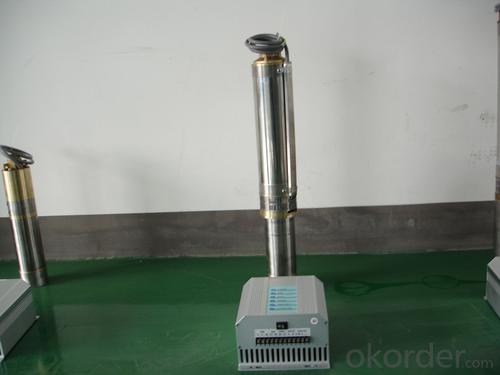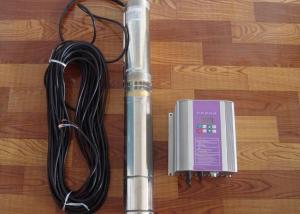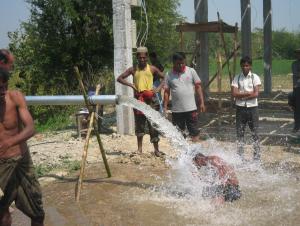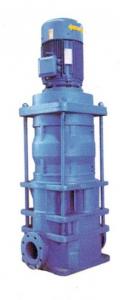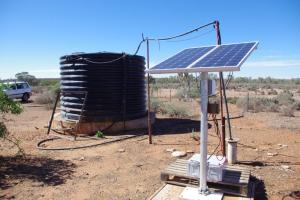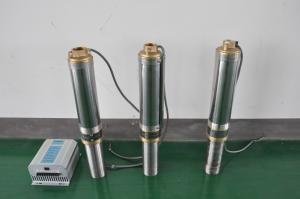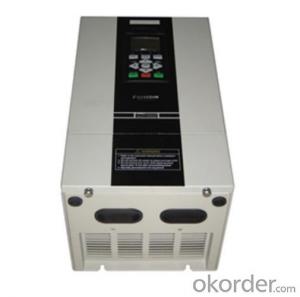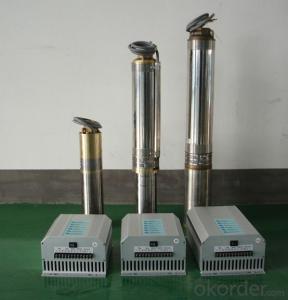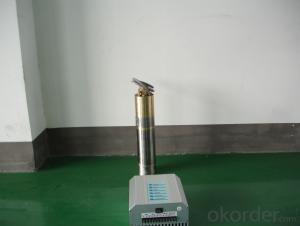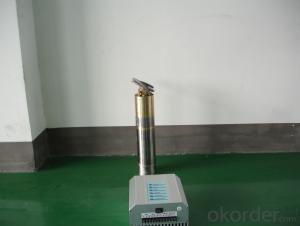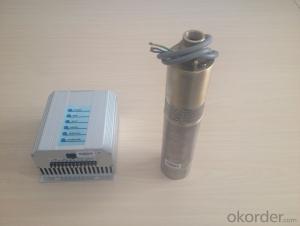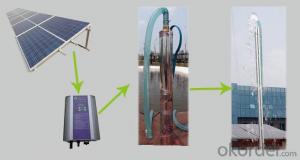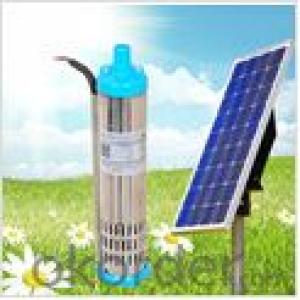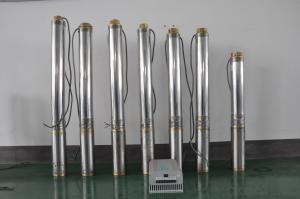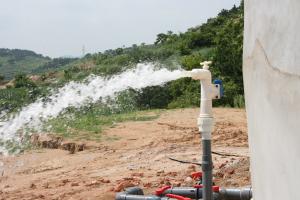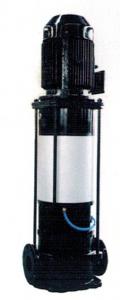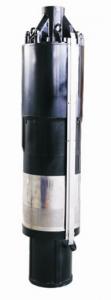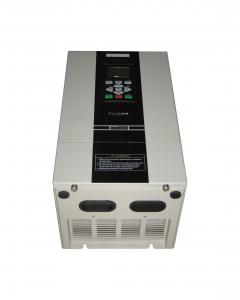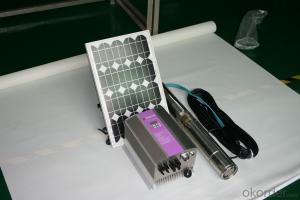Solar Pump Philippines DC Submersible Solar Pump
- Loading Port:
- China Main Port
- Payment Terms:
- TT OR LC
- Min Order Qty:
- -
- Supply Capability:
- -
OKorder Service Pledge
OKorder Financial Service
You Might Also Like
Item Description :
This superb new addition to our solar fountain range comes with a 10w solar panel,and a powerful fountain pump that is capable of producing fountains of up to 2m in height. As well as being easy to set up and use.Instruction manual is supplied for assembly and maintenance.
Solar Fountain Key Features :
Powered by direct sunlight
No high voltage electric mains required
Safe for children
Max. height of fountain: 2M
Max. flow capacity: 800 L/H(176 GAL)
10W Polycrystalline solar panel included
18V DC brushless pump
Solar Pump Features :
Can produce fountains up to : 2M (tube height) 1.4M (fountain height)
Comes with multiple nozzle accessories
Cable Length : 5M
Solar Panel Features :
10W peak power.
Polycrystalline highly efficient solar panel
Comes mounted in aluminium frame
Comes with ground stake and rotating knob so you can angle your panel toward the sun
What You Will Get :
10W solar panel
Solar pump
Ground Sake
Nozzle accessories
Precautions :
DO NOT alter or change the product itself or its components
Operate pump in freshwater only, never above 50 degrees celsius
Keep away from flammable liquids
Do not connect to any other power supply other than the included
- Q: Are solar pumps more cost-effective than traditional pumps?
- Yes, solar pumps are generally more cost-effective than traditional pumps. Solar pumps use renewable energy from the sun, which is free and abundant, eliminating the need for expensive fossil fuels or electricity. Additionally, solar pumps have lower operating and maintenance costs compared to traditional pumps, making them a more economical choice in the long run.
- Q: How does a solar pump handle power fluctuations in the electrical grid?
- A solar pump is typically designed to operate independently from the electrical grid, so it is not directly affected by power fluctuations in the grid. The pump relies on solar energy to power its operations, utilizing solar panels to convert sunlight into electricity and store it in batteries for continuous operation, even during cloudy periods or at night. This self-sustained system ensures that the pump can continue functioning reliably without relying on the grid's power supply or being impacted by its fluctuations.
- Q: What is the lifespan of a solar pump controller?
- The lifespan of a solar pump controller can vary depending on several factors. These factors include the quality of the controller, the operating conditions, and how well it is maintained. Generally, a well-made and properly maintained solar pump controller can last anywhere from 10 to 20 years. However, it is important to note that some controllers may have a shorter lifespan due to lower quality materials or components. Operating conditions also play a significant role in determining the lifespan of a solar pump controller. Extreme temperatures, excessive moisture, and exposure to harsh elements can all contribute to the degradation of the controller over time. Therefore, it is recommended to install the controller in a protected environment and ensure proper ventilation to prevent overheating. Regular maintenance is crucial for maximizing the lifespan of a solar pump controller. This includes cleaning the controller regularly, checking for any loose connections, and ensuring that the firmware and software are updated when necessary. Additionally, it is important to perform routine inspections to identify any signs of wear or damage and address them promptly to prevent further issues. In summary, the lifespan of a solar pump controller can range from 10 to 20 years, depending on factors such as quality, operating conditions, and maintenance. Taking proper care of the controller and addressing any issues in a timely manner can help extend its lifespan and ensure efficient operation of the solar pumping system.
- Q: Can solar pumps be used for water supply in educational institutions or universities?
- Yes, solar pumps can be used for water supply in educational institutions or universities. Solar pumps are a sustainable and environmentally friendly solution that can effectively pump water from wells, rivers, or other sources to meet the water supply needs of these institutions. They can provide a reliable and continuous water supply, especially in regions with abundant sunlight. Additionally, using solar pumps can reduce dependence on traditional electricity sources and help educational institutions contribute to a greener and more sustainable future.
- Q: Is it possible to store excess solar energy generated by the pump?
- Yes, it is possible to store excess solar energy generated by the pump. This can be done using various energy storage technologies such as batteries, pumped hydro storage, or thermal energy storage systems. Storing excess solar energy allows for its utilization during times of low solar generation or high energy demand, providing a more reliable and efficient energy supply.
- Q: Can a solar pump be used in areas with extreme temperatures?
- Yes, solar pumps can be used in areas with extreme temperatures. However, the performance and efficiency of the pump may be affected by the temperature extremes. It is important to select a solar pump that is specifically designed to withstand and operate in extreme temperatures to ensure reliable and efficient operation.
- Q: How does the cost of operating a solar pump compare to a traditional electric pump?
- The cost of operating a solar pump is generally lower compared to a traditional electric pump. Solar pumps rely on sunlight to generate power, which is free and abundant, eliminating the need for expensive electricity bills. Additionally, solar pumps have minimal maintenance requirements, reducing ongoing costs. In contrast, traditional electric pumps rely on grid electricity, which can be costly and subject to price fluctuations. Moreover, electric pumps often require more maintenance and can incur additional expenses for repairs and replacements. Overall, the cost savings associated with operating a solar pump make it a more cost-effective choice in the long run.
- Q: How does a solar pump handle water with high alkalinity?
- A solar pump can handle water with high alkalinity without any issues. The alkalinity of the water does not affect the functioning or efficiency of the solar pump in any way.
- Q: How does a solar pump help in reducing the risk of water conflicts?
- A solar pump helps in reducing the risk of water conflicts by providing a sustainable and reliable source of water for various purposes. By harnessing solar energy to power the pump, it eliminates the need for traditional fuel sources or electricity, making it cost-effective and environmentally friendly. This ensures uninterrupted access to water for communities, reducing the dependence on limited water resources and minimizing the potential for conflicts over water scarcity.
- Q: Can a solar pump be used for water supply in remote agricultural farms?
- Yes, a solar pump can be used for water supply in remote agricultural farms. Solar pumps are an excellent solution for remote areas where access to electricity is limited. They utilize solar energy to power the pump, which can be used to extract water from wells, boreholes, or other water sources. This renewable energy source is highly reliable, cost-effective, and environmentally friendly, making it a suitable option for water supply in remote agricultural farms.
Send your message to us
Solar Pump Philippines DC Submersible Solar Pump
- Loading Port:
- China Main Port
- Payment Terms:
- TT OR LC
- Min Order Qty:
- -
- Supply Capability:
- -
OKorder Service Pledge
OKorder Financial Service
Similar products
Hot products
Hot Searches
Related keywords

